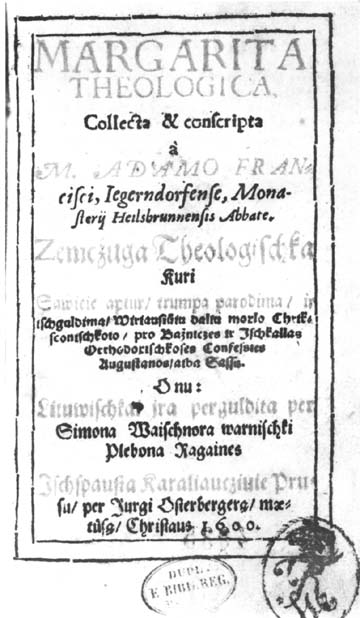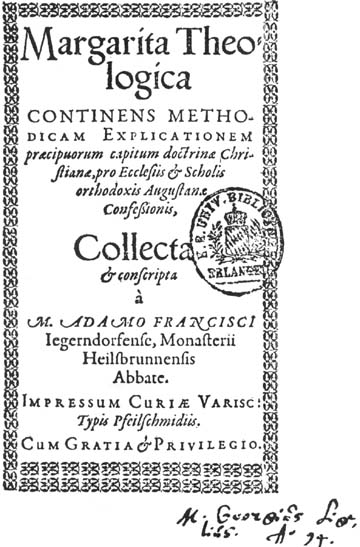Editors of this issue: Antanas Klimas, Ignas K. Skrupskelis, Thomas Remeikis

|
LITUANUS
LITHUANIAN QUARTERLY JOURNAL OF ARTS AND SCIENCES
Volume 18, No.2 - Summer 1972
Editors of this issue: Antanas Klimas, Ignas K. Skrupskelis, Thomas Remeikis Copyright © 1972 LITUANUS Foundation, Inc.
|

|
SOME REMARKS ABOUT SIMONAS VAIŠNORAS'
Žemčiūga TEOLOGIŠKA OR MARGARITA THEOLOGICA
"THEOLOGICAL PEARL" OF THE YEAR 1600
GORDON B. FORD, JR.
Northwestern University
The original text of the Žemčiūga Teologiška, the Margarita Theologica, was composed in Latin by Adam Franciscus of Jegerndorf, a German Lutheran abbot of the monastery of Heilsbrunn, and published in 1592 or 1593. Simonas Vaišnoras translated the Latin text into Lithuanian and published his Lithuanian version in 1600. The contents, as the title page indicates, consist of explanations of the principal doctrines of the Lutheran faith:
"Margarita Theologica, collected and composed by Adam Franciscus of Jegerndorf, abbot of the monastery of Heilsbrunn.
"The Žemčiūga Teologiška, which contains in itself a short exposition and interpretation of the main parts of Christian doctrine for the Churches and Schools of the Orthodox Confession of Augustana or Sasai and (which) has now been translated into Lithuanian by Simonas Vaišnoras, the pastor of Ragnit from Varniai. Printed at Kõnigsberg, Prussia by Jurgis Osterberger in the year of Christ 1600."
The work consists of a title page, a Latin preface of 6 double pages by Simonas Vaišnoras, a Lithuanian preface of 3½ double pages by Zacharias Blothno, Lithuanian pastor at Tilžė, a Lithuanian preface of 13 double pages by Vaišnoras, a prayer of 1½ double pages, 3½ double pages of errata, and 258 double pages of text. After the Žemčiūga Teologiška there begins a Lithuanian translation of an article by the German Lutheran Jokūbas Herbrand entitled Apie Dusches Zmonių Numirusuiu, Kaip su Jomis Destisi ("Concerning the Souls of Dead Men, What Becomes of Them"), pp. 259-271, and this is followed by 40 double pages of a Lithuanian translation of an article by the German Lutheran Aegidius Hunnius entitled Apie Popieszischkaie Missche ("Concerning the Papal Mass"). Both of these articles are without separate title pages, but the second one has different pagination. Inasmuch as both articles lack separate title pages and contain language identical to that found in Vaišnoras' Žemčiūga Teologiška, it is reasonable to attribute both of them to Vaišnoras.
Simonas Vaišnoras, who was born about 1545, stated in the preface to his Žemčiūga Teologiška that he was Žemaitic (a Samogitian or Low Lithuanian). On the title page of his work Vaišnoras referred to himself as being from the central Samogitian town of Varniai. This means that he was a dūnininkas by birth. He also mentioned that he studied at the University of Königsberg for three years with support from the Duke of Prussia. According to Georg Erler, Die Matrikel der Albertus-Universität zu Königsberg i. Pr., I (Leipzig, 1910), p. 43, Vaišnoras matriculated at the University of Königsberg in 1568. Thus he studied there from 1568 to 1571. Gottfried Ostermeyer in his work, Erste littauische Liedergeschichte (Königsberg, 1793), p. 267, informs us that Vaišnoras became pastor at Ragnit in 1576 and that he died at Ragnit twenty-four years later on November 16, 1600, the year of the publication of his book.

In addition to the Žemčiūga Teologiška Vaišnoras also translated into Lithuanian two hymns, which Lazarus Sengstock published, and revised Jonas Bretkūnas' Postilė and Bible.
According to David F. Robinson in his article, "Lithuanian Books in the British Museum (1578-1937)", General Linguistics X (1970), p. 76, there is a copy of the Žemčiūga Teologiška in the British Museum, no. 3557.aaa.9. The existence of this copy had not been pointed out until Professor Robinson's recent article. Maurycy Stankiewicz in his Bibliografia litewska od 1547 do 1701 r. (Kraków, 1889), pp. 24-26, mentioned two other known copies of the Žemčiūga Teologiška: the copy in the Univ. of Königsberg Library, no. Ce 494, and another copy in the library of Count Szembek at Porębe near Kraków. Vaclovas Biržiška in Lietuvių Bibliografija I (Kaunas, 1924), column 15, mentioned the same two copies as the only two copies known to him. Jurgis Gerullis indicated in Senieji lietuvių skaitymai I (Kaunas, 1927), p. 169, that he knew of only one copy of the text, that in the University of Königsberg Library, which he used as the source for the extract in his chrestomathy of Old Lithuanian texts. The text which I am using for my linguistic study is that copy which is now in the Scientific Library of the University of Vilnius, no. Lr 1379. According to Senoji lietuviška knyga Vilniaus universitete I (Vilnius, 1959), p. 29, one finds the stamp F. W. R. for Fridrichas Vilhelmas, rex (King Friedrich Vilhelm of Prussia) at the bottom of the title page. In addition, there also appears the stamp: Dupl(icata) e Bibl(ioteca) Reg(ia) R(egiomontana) ("Duplicate from the Royal Königsberg Library"). On the back of the cover is pasted the following: "Hieronim Wilder Polski antykwarjat naukovy" ("Polish Scholarly Antiquariat"), Warszawa, ul. Traugutta 8. Later this copy was acquired by the University of Kaunas Library, and in 1952 the University of Vilnius Library obtained it.

The original Latin text of the Margarita Theologica was formerly in the University of Erlangen Library but according to a letter which I received from the Library last year, it is no longer there. I am very grateful to Professor Christian S. Stang for supplying me with the microfilm and photocopies of this text which he obtained from the University of Erlangen Library a number of years ago.
The most important linguistic peculiarities of the Žemčiūga Teologiška appear to be the following:
So far as the orthography is concerned, it seems to resemble that found in the works of Mažvydas. However, here one finds the fricative ž represented more often by ź than by the ligature ß, and the affricate dž is represented more frequently by dcz than by dz. Example: nom. sg. dczauxmas 43a, 19.
Forms with a and o often alternate. For example, one finds both gen. sg. iakia and iokia; both nom. sg. źadis and źodis. However, forms with o definitely predominate. The forms in a are characteristic of northern Lithuanian dialects.
Even though Vaišnoras was Samogitian by birth, there are not many Samogitian forms in the Žemčiūga Teologiška. The so-called "Žemaitic Sound Law" does not operate in the text. The High Lithuanian prefix and preposition sa was often used by Vaišnoras instead of su. Sa was the form used in East Prussia, the area including Ragainė or Ragnit, where Vaišnoras lived from 1576 to 1600. The reason for the fact that Vaišnoras' work contains so few Samogitian features was his desire to write a work which would be read by both Low and High Lithuanians. Possible Žemaitic features in the text are the loss of final short vowels in the third person of the verb and in the neuter past passive participle, the first person singular subjunctive ending -čio, and the locative singular ending of ė-stems, ieie instead of ėje, but these features are also characteristic of High Lithuanian dialects which border on Samogitian dialects.
Another peculiarity of Vaišnoras' work is the use of an, en, in, and un to indicate what were most probably nasal vowels side by side with nasal vowels themselves or simple vowels without any nasal sign. The most likely explanation for this is that sometimes nasal signs were omitted altogether and that at other times they were replaced by the nasal sign n.
REFERENCES
Biržiška, Vaclovas. Lietuvių Bibliografija I. Kaunas, 1924.
Erler, Georg. Die Matrikel der Albertus-Universität zu Königsberg i. Pr., I. Leipzig, 1910.
Gerullis, Jurgis. Senieji lietuvių skaitymai. Kaunas, 1927.
Ostermeyer, Gottfried. Erste littauische Liedergeschichte. Königsberg, 1793.
Palionis, J. Lietuvių literatūrinė kalba XVI-XVII a. Vilnius, 1967.
Robinson, David F. "Lithuanian Books in the British Museum (1578-1937)", General Linguistics X (1970).
Senoji lietuviška knyga Vilniaus universitete I. Vilnius, 1959.
Stankiewicz, Maurycy. Bibliografia litewska od 1547 to 1701 r. Kraków, 1889.